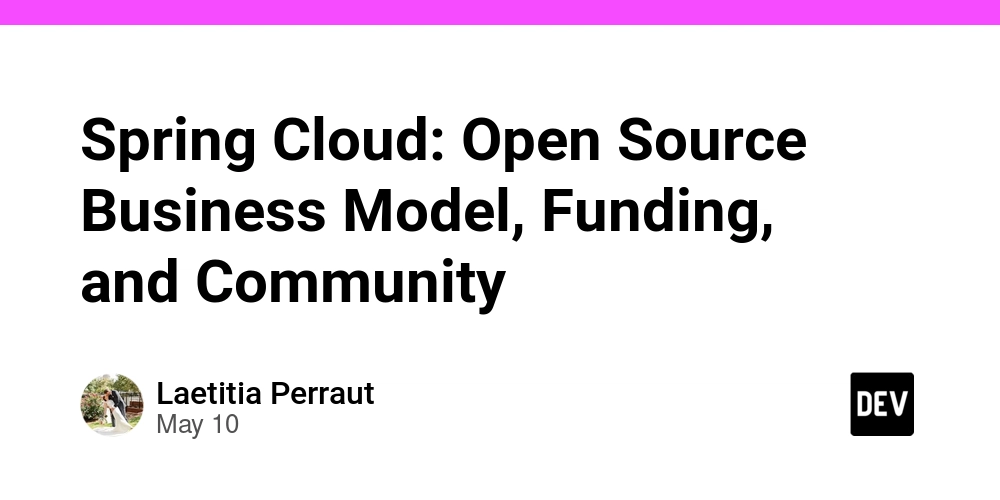Spring Cloud: Open Source Business Model, Funding, and Community
Abstract This post explores the innovations behind Spring Cloud, focusing on its open source business model, funding mechanisms, and vibrant community. We examine how the Apache 2.0 licensing, corporate support from VMware, and active community contributions create a sustainable ecosystem. Additionally, we delve into the technical features of Spring Cloud, how it revolutionizes distributed Java systems, detailed use cases, and future challenges and innovations. Finally, we highlight related resources and provide structured data and helpful links to guide further exploration. Introduction Spring Cloud is a leading framework that simplifies building distributed systems in Java. By integrating service discovery, configuration management, load balancing, and more, Spring Cloud creates an ecosystem that bridges robust technical innovation with a sustainable open source business model. Its use of the permissive Apache 2.0 license ensures legal clarity, while corporate backing from VMware and community engagement fuel continuous enhancements. This article builds on the analysis found in the Original Article: What is Spring Cloud? The Open Source Business Model, Funding, and Community and expands the discussion with additional contexts, examples, and a future outlook. Background and Context History and Definitions Spring Cloud emerged as Java developers sought a unified approach for implementing distributed architectures in an era when cloud computing, containerization, and microservice architectures were rapidly evolving. From its inception: Spring Cloud alleviated the complexity of configuring service registries, load balancing, and resilient communication for distributed systems. Apache 2.0 License ensured minimal restrictions while promoting collaboration and adaptation globally. VMware’s involvement introduced enterprise-grade reliability and technical expertise. This background sets the stage for broader ecosystem adoption, where each release of Spring Cloud reflects an innovative fusion of volunteer efforts and corporate sponsorship. Ecosystem Context Spring Cloud is deeply interconnected with other initiatives in the Spring ecosystem, such as Spring Boot. This synergy empowers developers to build cloud-native applications with ease. The vibrant community on GitHub (see Spring Cloud GitHub repository) and various forums ensures rapid issue resolution and continuous feature enhancement. Resources like the Spring Cloud Project Website offer comprehensive documentation and tutorials that further drive adoption. Core Concepts and Features Spring Cloud delivers multiple features tailored for building distributed systems in Java. Below are some core concepts: Key Features of Spring Cloud Service Discovery and Registration: Integrates with Eureka and Consul to locate microservices dynamically. Load Balancing: Provides client-side load balancing capabilities to manage high traffic gracefully. Configuration Management: Simplifies centralized configuration for dynamic application settings. Distributed Tracing and Monitoring: Facilitates tracking of requests across complex microservice architectures. Fault Tolerance and Resilience: Incorporates patterns such as circuit breakers to handle failures gracefully. A table summarizing core features and benefits is provided below: Feature Benefit Related Component Service Discovery Dynamic registration and location of services Eureka, Consul Load Balancing Equitable distribution of traffic across instances Ribbon, Spring Cloud LoadBalancer Configuration Management Centralized, dynamic configurations for microservices Spring Cloud Config Distributed Tracing and Monitoring End-to-end service observability Sleuth, Zipkin Fault Tolerance Handling failures without system-wide outages Hystrix (or Resilience4j) Funding Model and Open Source Business Spring Cloud exemplifies a hybrid funding model that blends community contributions with corporate sponsorship. Key funding aspects include: Open Source Funding Approaches: Contributions through GitHub Sponsors, donation drives, and corporate backing. Dual Licensing: While Spring Cloud is distributed under the Apache 2.0 license, discussions around innovative funding approaches—even tokenized contributions—are happening in the open source community (see Sustainable Funding for Open Source). Corporate Stewardship: With VMware lending technical expertise and financial support, Spring Cloud maintains enterprise-grade reliability. Community Engagement A strong community supports Spring Cloud. Developers worldwide share insights, report bugs, and contribute code improvements. There are various community-driven initiatives, such as: Open forums and technical workshops. Developer meet-ups and virtual conferences. Extensive technical documentation, code tutorials, and best-practice guides. Bullet Li

Abstract
This post explores the innovations behind Spring Cloud, focusing on its open source business model, funding mechanisms, and vibrant community. We examine how the Apache 2.0 licensing, corporate support from VMware, and active community contributions create a sustainable ecosystem. Additionally, we delve into the technical features of Spring Cloud, how it revolutionizes distributed Java systems, detailed use cases, and future challenges and innovations. Finally, we highlight related resources and provide structured data and helpful links to guide further exploration.
Introduction
Spring Cloud is a leading framework that simplifies building distributed systems in Java. By integrating service discovery, configuration management, load balancing, and more, Spring Cloud creates an ecosystem that bridges robust technical innovation with a sustainable open source business model. Its use of the permissive Apache 2.0 license ensures legal clarity, while corporate backing from VMware and community engagement fuel continuous enhancements. This article builds on the analysis found in the Original Article: What is Spring Cloud? The Open Source Business Model, Funding, and Community and expands the discussion with additional contexts, examples, and a future outlook.
Background and Context
History and Definitions
Spring Cloud emerged as Java developers sought a unified approach for implementing distributed architectures in an era when cloud computing, containerization, and microservice architectures were rapidly evolving. From its inception:
- Spring Cloud alleviated the complexity of configuring service registries, load balancing, and resilient communication for distributed systems.
- Apache 2.0 License ensured minimal restrictions while promoting collaboration and adaptation globally.
- VMware’s involvement introduced enterprise-grade reliability and technical expertise.
This background sets the stage for broader ecosystem adoption, where each release of Spring Cloud reflects an innovative fusion of volunteer efforts and corporate sponsorship.
Ecosystem Context
Spring Cloud is deeply interconnected with other initiatives in the Spring ecosystem, such as Spring Boot. This synergy empowers developers to build cloud-native applications with ease. The vibrant community on GitHub (see Spring Cloud GitHub repository) and various forums ensures rapid issue resolution and continuous feature enhancement. Resources like the Spring Cloud Project Website offer comprehensive documentation and tutorials that further drive adoption.
Core Concepts and Features
Spring Cloud delivers multiple features tailored for building distributed systems in Java. Below are some core concepts:
Key Features of Spring Cloud
- Service Discovery and Registration: Integrates with Eureka and Consul to locate microservices dynamically.
- Load Balancing: Provides client-side load balancing capabilities to manage high traffic gracefully.
- Configuration Management: Simplifies centralized configuration for dynamic application settings.
- Distributed Tracing and Monitoring: Facilitates tracking of requests across complex microservice architectures.
- Fault Tolerance and Resilience: Incorporates patterns such as circuit breakers to handle failures gracefully.
A table summarizing core features and benefits is provided below:
| Feature | Benefit | Related Component |
|---|---|---|
| Service Discovery | Dynamic registration and location of services | Eureka, Consul |
| Load Balancing | Equitable distribution of traffic across instances | Ribbon, Spring Cloud LoadBalancer |
| Configuration Management | Centralized, dynamic configurations for microservices | Spring Cloud Config |
| Distributed Tracing and Monitoring | End-to-end service observability | Sleuth, Zipkin |
| Fault Tolerance | Handling failures without system-wide outages | Hystrix (or Resilience4j) |
Funding Model and Open Source Business
Spring Cloud exemplifies a hybrid funding model that blends community contributions with corporate sponsorship. Key funding aspects include:
- Open Source Funding Approaches: Contributions through GitHub Sponsors, donation drives, and corporate backing.
- Dual Licensing: While Spring Cloud is distributed under the Apache 2.0 license, discussions around innovative funding approaches—even tokenized contributions—are happening in the open source community (see Sustainable Funding for Open Source).
- Corporate Stewardship: With VMware lending technical expertise and financial support, Spring Cloud maintains enterprise-grade reliability.
Community Engagement
A strong community supports Spring Cloud. Developers worldwide share insights, report bugs, and contribute code improvements. There are various community-driven initiatives, such as:
- Open forums and technical workshops.
- Developer meet-ups and virtual conferences.
- Extensive technical documentation, code tutorials, and best-practice guides.
Bullet List of Community Benefits:
- Rapid Issue Resolution: Community support accelerates troubleshooting.
- Sustainable Innovation: Continuous contributions lead to regular feature updates.
- Transparency: Open discussions about design choices and future improvements.
- Diverse Perspectives: Contributions from various companies and independent developers enrich the codebase.
Applications and Use Cases
Spring Cloud is implemented in various industries to modernize legacy systems and build resilient distributed architectures. Here are three practical use cases:
1. Modernizing Legacy Systems
Large enterprises have used Spring Cloud to transition from monolithic architectures to microservices. For example:
- Finance Sector: Banks can decouple legacy systems, providing better scalability and faster deployment cycles.
- Healthcare: Distributed patient management systems that require high availability and fault tolerance.
2. Cloud-Native Application Development
By leveraging Spring Cloud, organizations build applications that:
- Automatically scale with demand.
- Employ dynamic service discovery in elastic cloud environments.
- Integrate seamlessly with container orchestration (e.g., Kubernetes).
3. Digital Transformation in Logistics and Media
Businesses in logistics and media use Spring Cloud to improve operational efficiency:
- Logistics: Manage complex, distributed order processing in real-time.
- Media: Deliver resilient content streaming services that respond to fluctuating traffic loads.
These examples underscore how Spring Cloud’s features translate into improved performance, reduced downtime, and enhanced scalability.
Challenges and Limitations
Despite its success, Spring Cloud faces several challenges:
Technical Challenges
- Complexity in Microservices Orchestration: Managing a large number of microservices can be challenging without proper coordination tools.
- Integration Overhead: Integrating with non-Java systems may require additional adaptation layers.
- Performance Tuning: Distributed tracing and fault tolerance mechanisms can add overhead during high-demand periods.
Adoption Challenges
- Learning Curve: New developers may require time to master the intricacies of distributed system design.
- Evolving Ecosystem: Rapid technological changes sometimes demand frequent updates, which can disrupt established systems.
- Funding Volatility: Although corporate sponsorships provide stability, reliance on community contributions can sometimes be unpredictable. Discussions about alternative funding models such as tokenization (see Arbitrum and Open Source Funding) are ongoing.
Future Outlook and Innovations
Spring Cloud’s future is intertwined with advancements in cloud-native technologies and open source funding trends. Expected trends include:
Integration of Decentralized Funding Models
Innovative funding models – such as tokenizing open source contributions – are emerging. These approaches could complement traditional funding channels and provide a more diversified revenue stream for projects like Spring Cloud. For example, communities on License Token discuss decentralized finance approaches that could eventually influence enterprise projects.
Advancements in Cloud-Native Technologies
With the rise of container orchestration, IoT, and edge computing, Spring Cloud is constantly evolving:
- Enhanced Resilience: More sophisticated fault tolerance mechanisms using machine learning to predict failures.
- Improved Developer Experiences: Integrated toolchains that help developers monitor, debug, and optimize services in real time.
- Security and Compliance: Given increasing regulatory pressures, future iterations of Spring Cloud will need to tighten security and ensure compliance.
Cross-Chain and Distributed Ledger Innovations
Discussions around integrating blockchain-based funding and license management are gaining momentum. Articles such as Exploring Open Source Developer Funding Strategies show a trend towards blending distributed ledger technology with open source development to ensure transparency in funding.
Continued Community-Driven Innovation
Open source sustainability remains at the heart of Spring Cloud. As highlighted by various Dev.to posts, the power of community engagement is indispensable. The interplay of corporate sponsorship and grassroots innovation ensures that Spring Cloud adapts to technological challenges and remains relevant.
Summary
Spring Cloud stands as a paragon of open source innovation driven by a robust business model. Its seamless fusion of community contributions, corporate sponsorship from VMware, and the permissive Apache 2.0 license builds a sustainable ecosystem for distributed Java systems. In this post, we have explored the background and evolution of Spring Cloud, its core concepts and funding mechanisms, practical use cases, and the challenges it faces.
The key takeaways include:
- Strong Community Support: Open forums, regular code contributions, and transparent discussions drive innovation.
- Corporate and Community Funding: A hybrid model accepting traditional sponsorship and exploring innovative models like tokenization.
- Robust Feature Set: With features such as dynamic service discovery, load balancing, and centralized configuration, Spring Cloud remains essential for modern application development.
- Future Innovations: Continued evolution through emerging cloud-native trends and potential integration with decentralized funding models will ensure long-term sustainability.
Below is a quick bullet list summarizing the main benefits:
- Transparency and Legal Clarity: Enabled by the Apache 2.0 license.
- Rapid Innovation: Driven by active community and corporate engagement.
- Scalability and Resilience: Fundamental for modern distributed systems.
- Sustainability: A hybrid funding model ensures ongoing development and support.
Additional Resources and Related Links
For those looking for more in-depth research and discussions, consider exploring the following resources:
- Spring Cloud Project Website – Official documentation and project updates.
- Spring Cloud GitHub Repository – Source code and contribution guidelines.
- Sustainable Funding for Open Source – A comprehensive discussion on open source funding models.
- Exploring Open Source Developer Funding Strategies – Insightful post on funding mechanisms.
- Exploring JUnit: A Model of Community Innovation and Sustainable Funding – A related perspective on sustaining innovation in open source.
Conclusion
Spring Cloud is much more than just a distributed framework for Java. It is a beacon of open source sustainability that harmonizes technical excellence with community-driven funding and corporate support. As enterprises worldwide continue to embrace cloud-native architectures, frameworks like Spring Cloud, backed by innovative financial models and an engaged developer community, will remain critical in steering the future of distributed systems.
By understanding the evolution, funding strategies, and technical innovations behind Spring Cloud, developers and decision-makers can appreciate its profound impact on modern software development. The blend of traditional methodologies and emerging decentralized funding approaches promises an exciting future where open source projects can thrive amid evolving technological and financial landscapes.
As we move forward, the successful partnership between community enthusiasm and enterprise backing serves as a model for other projects. Whether you are a developer aiming to harness the power of cloud-native architecture, a stakeholder exploring robust enterprise solutions, or an enthusiast keen on open source funding mechanisms, Spring Cloud offers a compelling, sustainable pathway to innovation.
Explore further and join the discussion around sustainability and innovation in open source – your contributions and insights will help shape the future of distributed computing. Happy coding!
This post is written to provide technical insights into the sustainable funding and community-driven innovation of Spring Cloud. Its comprehensive nature aims to guide developers and enterprises alike in understanding the dynamic intersection of technology, business model, and open source collaboration.










































































































































































![[The AI Show Episode 146]: Rise of “AI-First” Companies, AI Job Disruption, GPT-4o Update Gets Rolled Back, How Big Consulting Firms Use AI, and Meta AI App](https://www.marketingaiinstitute.com/hubfs/ep%20146%20cover.png)




























































































































![[FREE EBOOKS] Offensive Security Using Python, Learn Computer Forensics — 2nd edition & Four More Best Selling Titles](https://www.javacodegeeks.com/wp-content/uploads/2012/12/jcg-logo.jpg)



![Ditching a Microsoft Job to Enter Startup Purgatory with Lonewolf Engineer Sam Crombie [Podcast #171]](https://cdn.hashnode.com/res/hashnode/image/upload/v1746753508177/0cd57f66-fdb0-4972-b285-1443a7db39fc.png?#)
































































































































































































































-xl.jpg)













![As Galaxy Watch prepares a major change, which smartwatch design to you prefer? [Poll]](https://i0.wp.com/9to5google.com/wp-content/uploads/sites/4/2024/07/Galaxy-Watch-Ultra-and-Apple-Watch-Ultra-1.jpg?resize=1200%2C628&quality=82&strip=all&ssl=1)













![Apple M4 iMac Drops to New All-Time Low Price of $1059 [Deal]](https://www.iclarified.com/images/news/97281/97281/97281-640.jpg)
![Beats Studio Buds + On Sale for $99.95 [Lowest Price Ever]](https://www.iclarified.com/images/news/96983/96983/96983-640.jpg)

![New iPad 11 (A16) On Sale for Just $277.78! [Lowest Price Ever]](https://www.iclarified.com/images/news/97273/97273/97273-640.jpg)






































![Apple's 11th Gen iPad Drops to New Low Price of $277.78 on Amazon [Updated]](https://images.macrumors.com/t/yQCVe42SNCzUyF04yj1XYLHG5FM=/2500x/article-new/2025/03/11th-gen-ipad-orange.jpeg)



![[Exclusive] Infinix GT DynaVue: a Prototype that could change everything!](https://www.gizchina.com/wp-content/uploads/images/2025/05/Screen-Shot-2025-05-10-at-16.07.40-PM-copy.png)























































